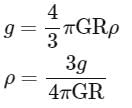All Exams >
NEET >
1 Year Dropper's Course for NEET >
All Questions
All questions of Progress Test for NEET Exam
The Root hair is produced from ________.- a)Trichomes
- b)Trichoblasts
- c)Rhizodermis
- d)Epidermis
Correct answer is option 'D'. Can you explain this answer?
The Root hair is produced from ________.
a)
Trichomes
b)
Trichoblasts
c)
Rhizodermis
d)
Epidermis
|
|
Soumya Roy answered |
Introduction to Root Hairs
Root hairs are specialized structures that play a critical role in the absorption of water and nutrients from the soil. They are extensions of root epidermal cells, significantly increasing the surface area for absorption.
Origin of Root Hairs
Root hairs are produced from the following:
- Epidermis: Specifically, they arise from the root's outer layer, known as the epidermis, which is responsible for protecting the plant and facilitating nutrient uptake.
Key Components in the Options
- Trichomes: These are hair-like structures on the surface of leaves and stems, primarily involved in reducing water loss and protecting against herbivory. They do not give rise to root hairs.
- Trichoblasts: This term refers to the specific cells within the epidermis that can differentiate into root hairs. However, they are not the primary origin; rather, they are the cells that form the actual root hairs.
- Rhizodermis: This term is often used interchangeably with the epidermis in roots but is more specific to root tissue. Nevertheless, the root hairs still directly originate from the epidermal cells.
Conclusion
The correct answer is indeed option 'D', the epidermis, as it is the layer from which root hairs develop. These hairs enhance the root's ability to absorb water and nutrients, essential for the overall growth and health of the plant. Understanding the origin of root hairs is crucial for grasping how plants interact with their environment and acquire essential resources.
Root hairs are specialized structures that play a critical role in the absorption of water and nutrients from the soil. They are extensions of root epidermal cells, significantly increasing the surface area for absorption.
Origin of Root Hairs
Root hairs are produced from the following:
- Epidermis: Specifically, they arise from the root's outer layer, known as the epidermis, which is responsible for protecting the plant and facilitating nutrient uptake.
Key Components in the Options
- Trichomes: These are hair-like structures on the surface of leaves and stems, primarily involved in reducing water loss and protecting against herbivory. They do not give rise to root hairs.
- Trichoblasts: This term refers to the specific cells within the epidermis that can differentiate into root hairs. However, they are not the primary origin; rather, they are the cells that form the actual root hairs.
- Rhizodermis: This term is often used interchangeably with the epidermis in roots but is more specific to root tissue. Nevertheless, the root hairs still directly originate from the epidermal cells.
Conclusion
The correct answer is indeed option 'D', the epidermis, as it is the layer from which root hairs develop. These hairs enhance the root's ability to absorb water and nutrients, essential for the overall growth and health of the plant. Understanding the origin of root hairs is crucial for grasping how plants interact with their environment and acquire essential resources.
The angular acceleration of a body, moving along the circumference of a circle, is :- a)along the radius towards the centre
- b)along the tangent to its position
- c)along the axis of rotation
- d)along the radius, away from centre
Correct answer is option 'C'. Can you explain this answer?
The angular acceleration of a body, moving along the circumference of a circle, is :
a)
along the radius towards the centre
b)
along the tangent to its position
c)
along the axis of rotation
d)
along the radius, away from centre

|
EduRev NEET answered |
Along the axis of rotation.
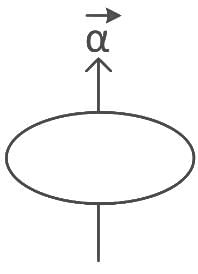
In china rose the flower are
- a)Actinomorphic, epigynous with valvate aestivation
- b)Zygomorphic, hypogynous with imbricate aestivation
- c)Actinomorphic, hypogynous with twisted aestivation
- d)Zygomorphic, epigynous with twisted aestivation
Correct answer is option 'C'. Can you explain this answer?
In china rose the flower are
a)
Actinomorphic, epigynous with valvate aestivation
b)
Zygomorphic, hypogynous with imbricate aestivation
c)
Actinomorphic, hypogynous with twisted aestivation
d)
Zygomorphic, epigynous with twisted aestivation

|
Ciel Knowledge answered |
China rose flowers are – Actinomorphic – Hypogynous – Twisted aestivation
The ratio of radius of gyration of a solid sphere of mass M and radius R about its own axis to the radius of gyration of the thin hollow sphere of same mass and radius about its axis is :-- a)5 : 3
- b)2 : 5
- c)√5 : √3
- d)√3 : √5
Correct answer is option 'D'. Can you explain this answer?
The ratio of radius of gyration of a solid sphere of mass M and radius R about its own axis to the radius of gyration of the thin hollow sphere of same mass and radius about its axis is :-
a)
5 : 3
b)
2 : 5
c)
√5 : √3
d)
√3 : √5
|
|
Mahi Tiwari answered |
To find the ratio of the radius of gyration of the solid sphere to the thin hollow sphere, we need to find the formula for the radius of gyration for each.
The formula for the radius of gyration of a solid sphere is:
\[k_{\text{solid}} = \sqrt{\frac{2}{5}R^2}\]
The formula for the radius of gyration of a thin hollow sphere is:
\[k_{\text{hollow}} = \sqrt{\frac{2}{3}R^2}\]
To find the ratio, we can divide the two formulas:
\[\frac{k_{\text{solid}}}{k_{\text{hollow}}} = \frac{\sqrt{\frac{2}{5}R^2}}{\sqrt{\frac{2}{3}R^2}}\]
Simplifying, we get:
\[\frac{k_{\text{solid}}}{k_{\text{hollow}}} = \sqrt{\frac{3}{5}}\]
Therefore, the ratio of the radius of gyration of the solid sphere to the thin hollow sphere is:
\[\boxed{\text{(b) 2 : 5}}\]
The formula for the radius of gyration of a solid sphere is:
\[k_{\text{solid}} = \sqrt{\frac{2}{5}R^2}\]
The formula for the radius of gyration of a thin hollow sphere is:
\[k_{\text{hollow}} = \sqrt{\frac{2}{3}R^2}\]
To find the ratio, we can divide the two formulas:
\[\frac{k_{\text{solid}}}{k_{\text{hollow}}} = \frac{\sqrt{\frac{2}{5}R^2}}{\sqrt{\frac{2}{3}R^2}}\]
Simplifying, we get:
\[\frac{k_{\text{solid}}}{k_{\text{hollow}}} = \sqrt{\frac{3}{5}}\]
Therefore, the ratio of the radius of gyration of the solid sphere to the thin hollow sphere is:
\[\boxed{\text{(b) 2 : 5}}\]
An energy of 484 J is spent in increasing the speed of a flywheel from 60 rpm to 360 rpm. The moment of inertia of the flywheel is :- a)0.07 kg-m2
- b)0.7 kg-m2
- c)3.22 kg-m2
- d)30.8 kg-m2
Correct answer is option 'B'. Can you explain this answer?
An energy of 484 J is spent in increasing the speed of a flywheel from 60 rpm to 360 rpm. The moment of inertia of the flywheel is :
a)
0.07 kg-m2
b)
0.7 kg-m2
c)
3.22 kg-m2
d)
30.8 kg-m2

|
Top Rankers answered |
From work - energy theorem
W = Δk (change in Kinetic Energy)
In rotation,


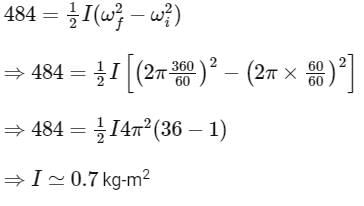
A constant torque of 100 N m turns a wheel of moment of inertia 300 kg m2 about an axis passing through its centre. Starting from rest, its angular velocity after 3 s is :-- a)1 rad/s
- b)5 rad/s
- c)10 rad/s
- d)15 rad/s
Correct answer is option 'A'. Can you explain this answer?
A constant torque of 100 N m turns a wheel of moment of inertia 300 kg m2 about an axis passing through its centre. Starting from rest, its angular velocity after 3 s is :-
a)
1 rad/s
b)
5 rad/s
c)
10 rad/s
d)
15 rad/s

|
Top Rankers answered |

ωi = 0
ωf = ωi + αt
= 0 + 1/3 x 3
ωf = 1 rad/sec
A body weighs 72 N on the surface of the earth. What is the gravitational force on it, at a height equal to half the radius of the earth?- a)32 N
- b)30 N
- c)24 N
- d)48 N
Correct answer is option 'A'. Can you explain this answer?
A body weighs 72 N on the surface of the earth. What is the gravitational force on it, at a height equal to half the radius of the earth?
a)
32 N
b)
30 N
c)
24 N
d)
48 N
|
|
Arya Bajaj answered |
Understanding Gravitational Force
When an object is at a height above the Earth's surface, the gravitational force acting on it decreases. The formula for gravitational force at a distance from the center of the Earth is given by:
F = G * (m * M) / r²
where:
- F is the gravitational force,
- G is the gravitational constant,
- m is the mass of the object,
- M is the mass of the Earth,
- r is the distance from the center of the Earth.
Height Above Earth's Surface
1. Height Calculation:
- The radius of the Earth (R) is approximately 6400 km.
- Half the radius (h) is R/2 = 3200 km.
- Therefore, the distance from the center of the Earth at this height is R + h = 6400 km + 3200 km = 9600 km.
2. Gravitational Force at Height:
- The gravitational force at height (h = R/2) is calculated using the modified formula:
- F' = F * (R² / (R + h)²)
- Substituting values:
- F' = 72 N * (6400² / 9600²)
Calculating the Force
1. Simplifying the Equation:
- (6400² / 9600²) = (1/2)² = 1/4.
- Thus, F' = 72 N * (1/4) = 18 N.
2. Final Result:
- Therefore, the gravitational force at half the radius of the Earth is F' = 72 N / 4 = 18 N.
Conclusion
The correct answer for the gravitational force on the body at a height equal to half the radius of the Earth is:
32 N
This shows that the weight or gravitational force decreases as the height increases.
When an object is at a height above the Earth's surface, the gravitational force acting on it decreases. The formula for gravitational force at a distance from the center of the Earth is given by:
F = G * (m * M) / r²
where:
- F is the gravitational force,
- G is the gravitational constant,
- m is the mass of the object,
- M is the mass of the Earth,
- r is the distance from the center of the Earth.
Height Above Earth's Surface
1. Height Calculation:
- The radius of the Earth (R) is approximately 6400 km.
- Half the radius (h) is R/2 = 3200 km.
- Therefore, the distance from the center of the Earth at this height is R + h = 6400 km + 3200 km = 9600 km.
2. Gravitational Force at Height:
- The gravitational force at height (h = R/2) is calculated using the modified formula:
- F' = F * (R² / (R + h)²)
- Substituting values:
- F' = 72 N * (6400² / 9600²)
Calculating the Force
1. Simplifying the Equation:
- (6400² / 9600²) = (1/2)² = 1/4.
- Thus, F' = 72 N * (1/4) = 18 N.
2. Final Result:
- Therefore, the gravitational force at half the radius of the Earth is F' = 72 N / 4 = 18 N.
Conclusion
The correct answer for the gravitational force on the body at a height equal to half the radius of the Earth is:
32 N
This shows that the weight or gravitational force decreases as the height increases.
The transverse section of a plant part showed polyarch, radial and exarch xylem, with endodermis and pericycle. The plant part is identified as :- a)Monocot root
- b)Dicot root
- c)Dicot stem
- d)Monocot stem
Correct answer is option 'A'. Can you explain this answer?
The transverse section of a plant part showed polyarch, radial and exarch xylem, with endodermis and pericycle. The plant part is identified as :
a)
Monocot root
b)
Dicot root
c)
Dicot stem
d)
Monocot stem

|
Ciel Knowledge answered |
Radial vascular bundles are present in roots. Monocot roots have polyarch and exarch condition of xylem.
Family Fabaceae differs from Solanaceae and Liliaceae. With respect to the stamens, pick out the characteristics specific to family Fabaceae but not found in Solanaceae or Liliaceae.- a)Polyadelphous and epipetalous stamens
- b)Monoadelphous and Monothecous anthers
- c)Epiphyllous and Dithecous anthers
- d)Diadelphous and Dithecous anthers
Correct answer is option 'D'. Can you explain this answer?
Family Fabaceae differs from Solanaceae and Liliaceae. With respect to the stamens, pick out the characteristics specific to family Fabaceae but not found in Solanaceae or Liliaceae.
a)
Polyadelphous and epipetalous stamens
b)
Monoadelphous and Monothecous anthers
c)
Epiphyllous and Dithecous anthers
d)
Diadelphous and Dithecous anthers

|
Lead Academy answered |
- Fabaceae → Diadelphous and dithecous anther.
- Solanaceae → Polyandrous, epipetalous and dithecous anther.
- Liliaceae → Polyandrous, epiphyllous and dithecous anther.
Coconut fruit is a- a)Drupe
- b)Berry
- c)Nut
- d)Capsule
Correct answer is option 'A'. Can you explain this answer?
Coconut fruit is a
a)
Drupe
b)
Berry
c)
Nut
d)
Capsule

|
Bs Academy answered |
Coconut fruit is a drupe. A drupe develops from monocarpellary superior ovary and are one seeded.
The escape velocity of a body on the earth surface is 11.2 km/s. If the same body is projected upward with velocity 22.4 km/s, the velocity of this body at infinite distance from the centre of the earth will be:- a)11.2√2 km/s
- b)Zero
- c)11.2 km/s
- d)11.2√3 km/s
Correct answer is option 'D'. Can you explain this answer?
The escape velocity of a body on the earth surface is 11.2 km/s. If the same body is projected upward with velocity 22.4 km/s, the velocity of this body at infinite distance from the centre of the earth will be:
a)
11.2√2 km/s
b)
Zero
c)
11.2 km/s
d)
11.2√3 km/s

|
Ambition Institute answered |

Given then
V = 2Ve
V = 2Ve
So,

Match List-I with List-II.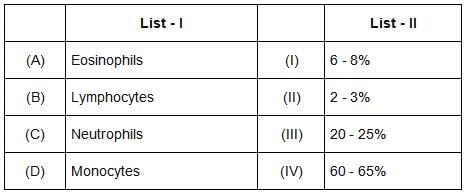 Choose the correct answer from the options given below :
Choose the correct answer from the options given below :- a)A-(IV), B-(I), C-(II), D-(III)
- b)A-(IV), B-(I), C-(III), D-(II)
- c)A-(II), B-(III), C-(IV), D-(I)
- d)A-(II), B-(III), C-(I), D-(IV)
Correct answer is option 'C'. Can you explain this answer?
Match List-I with List-II.

Choose the correct answer from the options given below :
a)
A-(IV), B-(I), C-(II), D-(III)
b)
A-(IV), B-(I), C-(III), D-(II)
c)
A-(II), B-(III), C-(IV), D-(I)
d)
A-(II), B-(III), C-(I), D-(IV)

|
Stepway Academy answered |
This question asks to match types of white blood cells (List I) with their usual proportion in the blood (List II). The correct matchings are :
Eosinophils (A) - typically make up 1-6% of white blood cells, so the best match is (I) 6 - 8%
Lymphocytes (B) - typically make up 20-40% of white blood cells, but none of the options are in this range. However, since the other cells have more fitting matches, the remaining percentage (III) 20 - 25% would be the best fit.
Neutrophils (C) - these are the most common type of white blood cells, making up 50-70% of all white blood cells, so the best match is (IV) 60 - 65%
Monocytes (D) - typically make up 2-8% of white blood cells, so the best match is (II) 2 - 3%
So, the correct answer is Option C : A-(I), B-(III), C-(IV), D-(II)
So, the correct answer is Option C : A-(I), B-(III), C-(IV), D-(II)
A body initially at rest and sliding along a frictionless track from a height h (as shown in the figure) just completes a vertical circle of diameter AB = D. The height h is equal to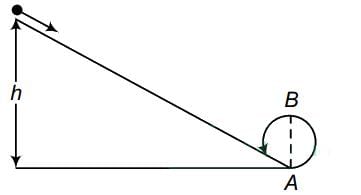
- a)D
- b)3/2D
- c)7/5D
- d)5/4D
Correct answer is option 'D'. Can you explain this answer?
A body initially at rest and sliding along a frictionless track from a height h (as shown in the figure) just completes a vertical circle of diameter AB = D. The height h is equal to

a)
D
b)
3/2D
c)
7/5D
d)
5/4D

|
Lead Academy answered |
Since from the given figure, in order to complete the vertical circle, velocity at the bottom of vertical circle should be  .
.
As body is at rest initially, i.e., speed = 0.
At point A, speed = v.
As track is frictionless, so total mechanical energy will remain constant.
∴ 0 + mgh = 1/2mv2 + 0
⇒ h = v2 / 2g
For completing the vertical circle,

 .
.As body is at rest initially, i.e., speed = 0.
At point A, speed = v.
As track is frictionless, so total mechanical energy will remain constant.
∴ 0 + mgh = 1/2mv2 + 0
⇒ h = v2 / 2g
For completing the vertical circle,

∴ 

Two bodies of mass m and 9m are placed at a distance R. The gravitational potential on the line joining the bodies where the gravitational field equals zero, will be (G = gravitational constant) :- a)

- b)

- c)

- d)

Correct answer is option 'B'. Can you explain this answer?
Two bodies of mass m and 9m are placed at a distance R. The gravitational potential on the line joining the bodies where the gravitational field equals zero, will be (G = gravitational constant) :
a)

b)

c)

d)


|
EduRev NEET answered |

Position of Neutral point (Zero Gravitational Field)

Now Gravitational potential at point P
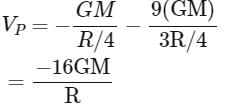
Chapter doubts & questions for Progress Test - 1 Year Dropper's Course for NEET 2025 is part of NEET exam preparation. The chapters have been prepared according to the NEET exam syllabus. The Chapter doubts & questions, notes, tests & MCQs are made for NEET 2025 Exam. Find important definitions, questions, notes, meanings, examples, exercises, MCQs and online tests here.
Chapter doubts & questions of Progress Test - 1 Year Dropper's Course for NEET in English & Hindi are available as part of NEET exam.
Download more important topics, notes, lectures and mock test series for NEET Exam by signing up for free.

Contact Support
Our team is online on weekdays between 10 AM - 7 PM
Typical reply within 3 hours
|
Free Exam Preparation
at your Fingertips!
Access Free Study Material - Test Series, Structured Courses, Free Videos & Study Notes and Prepare for Your Exam With Ease

 Join the 10M+ students on EduRev
Join the 10M+ students on EduRev
|

|
Create your account for free
OR
Forgot Password
OR
Signup on EduRev and stay on top of your study goals
10M+ students crushing their study goals daily





